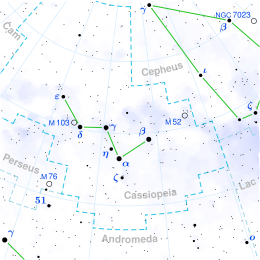Phi Cassiopeiae (φ Cas, φ Cassiopeiae) is a multiple star in the constellation Cassiopeia with a combined apparent magnitude of +4.95. The two brightest components are A and C, sometimes called φ1 and φ2 Cas. φ Cas A is an F0 bright supergiant of magnitude 4.95 and φ Cas C is a 7.08 magnitude B6 supergiant at 134".
- ^ a b c d e Vallenari, A.; et al. (Gaia collaboration) (2023). "Gaia Data Release 3. Summary of the content and survey properties". Astronomy and Astrophysics. 674: A1. arXiv:2208.00211. Bibcode:2023A&A...674A...1G. doi:10.1051/0004-6361/202243940. S2CID 244398875. Gaia DR3 record for this source at VizieR.
- ^ a b c d Eggleton, P. P.; Tokovinin, A. A. (2008). "A catalogue of multiplicity among bright stellar systems". Monthly Notices of the Royal Astronomical Society. 389 (2): 869. arXiv:0806.2878. Bibcode:2008MNRAS.389..869E. doi:10.1111/j.1365-2966.2008.13596.x. S2CID 14878976.
- ^ a b c d e Vallenari, A.; et al. (Gaia collaboration) (2023). "Gaia Data Release 3. Summary of the content and survey properties". Astronomy and Astrophysics. 674: A1. arXiv:2208.00211. Bibcode:2023A&A...674A...1G. doi:10.1051/0004-6361/202243940. S2CID 244398875. Gaia DR3 record for this source at VizieR.
- ^ a b c d Ducati, J. R. (2002). "VizieR Online Data Catalog: Catalogue of Stellar Photometry in Johnson's 11-color system". CDS/ADC Collection of Electronic Catalogues. 2237. Bibcode:2002yCat.2237....0D.
- ^ Mermilliod, J. C.; Mayor, M.; Udry, S. (2008). "Red giants in open clusters. XIV. Mean radial velocities for 1309 stars and 166 open clusters". Astronomy and Astrophysics. 485 (1): 303–314. Bibcode:2008A&A...485..303M. CiteSeerX 10.1.1.30.7545. doi:10.1051/0004-6361:200809664.
- ^ a b c d Kovtyukh, V. V.; Gorlova, N.; Belik, S. I. (2012). "Accurate luminosities from the oxygen 7771-4 a triplet and the fundamental parameters of F-G supergiants". Monthly Notices of the Royal Astronomical Society. 423 (4): 3268. arXiv:1204.4115v1. Bibcode:2012MNRAS.423.3268K. doi:10.1111/j.1365-2966.2012.21117.x. S2CID 118683158.
- ^ Kharchenko, N. V.; Scholz, R.-D.; Piskunov, A. E.; Röser, S.; Schilbach, E. (2007). "Astrophysical supplements to the ASCC-2.5: Ia. Radial velocities of ˜55000 stars and mean radial velocities of 516 Galactic open clusters and associations". Astronomische Nachrichten. 328 (9): 889. arXiv:0705.0878. Bibcode:2007AN....328..889K. doi:10.1002/asna.200710776. S2CID 119323941.
- ^ a b c Leitherer, C.; Wolf, B. (1984). "Early-type stars in OB associations in the infrared. I Extinction law and IR excesses". Astronomy and Astrophysics. 132: 151. Bibcode:1984A&A...132..151L.
- ^ a b c Rosenzweig, P.; Anderson, L. (1993). "A determination of the basic atmospheric parameters of Phi Cassiopeiae". The Astrophysical Journal. 411: 207. Bibcode:1993ApJ...411..207R. doi:10.1086/172820.
- ^ Cite error: The named reference
ferrowas invoked but never defined (see the help page). - ^ Evans, Christopher J.; Howarth, Ian D. (2003). "Characteristics and classification of A-type supergiants in the Small Magellanic Cloud". Monthly Notices of the Royal Astronomical Society. 345 (4): 1223. arXiv:astro-ph/0308125. Bibcode:2003MNRAS.345.1223E. doi:10.1046/j.1365-2966.2003.07038.x. S2CID 15290757.
- ^ Cite error: The named reference
zhangwas invoked but never defined (see the help page). - ^ a b c d McErlean, N. D.; Lennon, D. J.; Dufton, P. L. (1999). "Galactic B-supergiants: A non-LTE model atmosphere analysis to estimate atmospheric parameters and chemical compositions". Astronomy and Astrophysics. 349: 553. Bibcode:1999A&A...349..553M.
